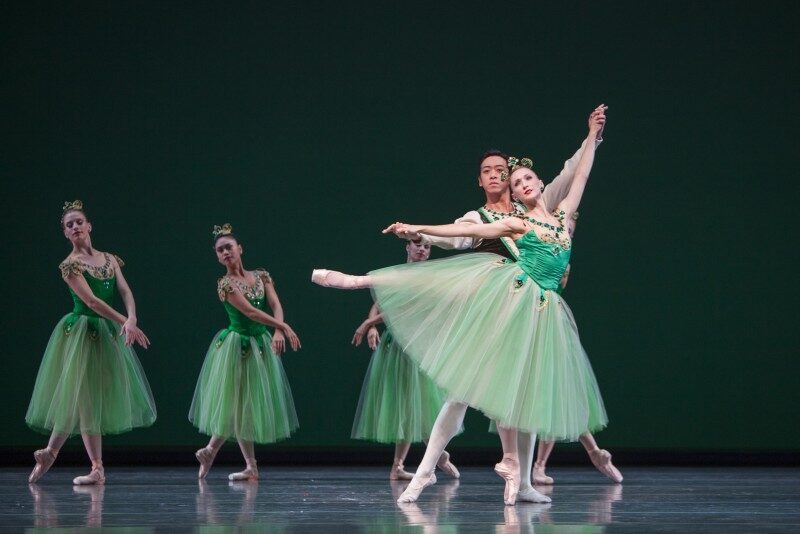Shining Bright
Review of Jewels at Pacific Northwest Ballet by Megan R.

The show starts off with a bang — or rather, with a timpani. With the glittering curtain still down, the sound of Tchaikovsky soars from the orchestra pit and fills the concert hall. Then the curtain lifts and more then a dozen dancers come into view. As they leap and twirl across the stage, the dancers, dressed in sparkly bodices and flowing green skirts, truly become jewels.
Jewels at Pacific Northwest Ballet doesn’t set out to tell a story. When it premiered in 1967, George Balanchine’s Jewels became the first full-length plotless ballet and its three parts — “Emeralds,” “Rubies,” and “Diamonds” — are linked only by their jewel-toned costumes.
"Emeralds" is the most restrained of the three acts; the music composed by Gabriel Faure is muted, the dancers graceful but understated. The pair dances prove to be the exception. William Lin-Yee lifts his partner, Elizabeth Murphy, and for a moment her tutu fans out around her and she appears weightless. Charles McCall is also brilliant. Although he lacks some of the precision of Lin-Yee, his face and movements are more expressive. At only 30 minutes, “Emeralds” goes by fast, and after a short intermission “Rubies” takes the stage.
Where “Emeralds” is subtle and understated, “Rubies” is brash and exciting. This is contemporary ballet; the dancers wiggle their hips as Allen Dameron hammers out a jazzy score on piano. At one point the dancers come dangerously close to grinding. Leta Biassuci and Jonathan Porretta have great chemistry as the central couple, but Biasucci steals the show as she is breathtaking in both her precision and expressiveness. Together they will transport you to 1920s, evoking the romance of a flapper girl and her love-struck suitor. At once both comical and passionate, the story they weave is the centerpiece of the whole show.
That’s the thing with this ballet: Jewels doesn’t set out to tell a story but it still does. And while there may be no overarching plotlines, there are still small stories — stories told through stolen looks and tender embraces. In the first act, Lin-Yee and his partner tell the story of courtly love in “Emeralds,” which contrasts with Biassuci and Poretta’s fiery affair in “Rubies.” It’s these little stories that make Jewels so great, which is why I think the third act fell flat.
Although the costumes are beautiful and the first bassoonist does a great job playing Tchaikovsky’s Symphony No. 3 in D Major, “Diamonds” doesn’t have a story to tell. “Diamonds” is exactly what Jewels claims to be: It’s dancing that isn’t bogged down by story. The dancers move effortlessly, creating dazzling shapes and patterns, but somehow that isn’t enough. Like the diamond itself, the third act is colorless and uncaring. Because of this, the final act loses much of the passion that Pacific Northwest Ballet cultivated in the first two acts.
This isn’t to say you shouldn’t go see Jewels. Even if "Diamonds" is a little dull, the first two acts more than make up for it. Go see Jewels. Go for the music, go for costumes, and go for the hot male dancers. Just remember to pay attention to the little stories hidden within the choreography because although Jewels is an abstract ballet, the little stories are what make Jewels shine.
Jewels
Pacific Northwest Ballet
September 26 - October 5


